Quantitative Research Article Appraisal Report: Healthcare
VerifiedAdded on 2022/08/16
|5
|1075
|173
Report
AI Summary
This report provides an appraisal of a quantitative research article by Tuokko et al. (2016), which investigated the factors influencing driving behaviors and health perceptions in elderly individuals. The appraisal critically examines the study's methodology, including participant sampling, data collection methods (questionnaires), and ethical considerations. The report highlights the use of purposive sampling and its potential biases, suggesting random sampling as a more robust alternative. It also reviews the questionnaires used and their relevance to the research question. The analysis of findings, limitations, and implications of the study are discussed, including the role of negative health attitudes as mediators. The report also identifies limitations such as the lack of qualitative measures and non-randomized sampling. Finally, the report provides recommendations for future research, emphasizing the need for physician-reported health symptoms and other life skills besides driving. The conclusion stresses the importance of internal and external validity in quantitative research.
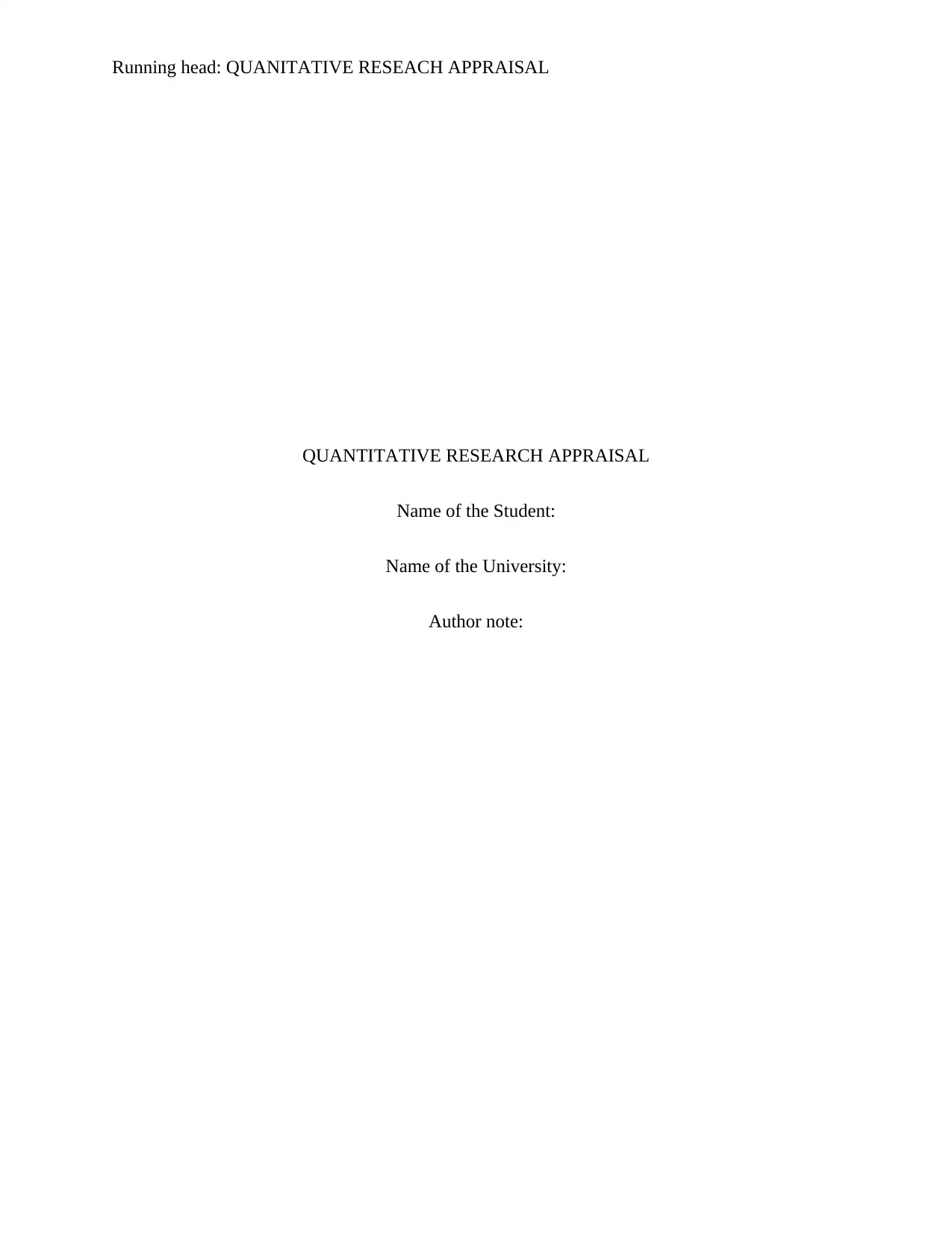
Running head: QUANITATIVE RESEACH APPRAISAL
QUANTITATIVE RESEARCH APPRAISAL
Name of the Student:
Name of the University:
Author note:
QUANTITATIVE RESEARCH APPRAISAL
Name of the Student:
Name of the University:
Author note:
Paraphrase This Document
Need a fresh take? Get an instant paraphrase of this document with our AI Paraphraser
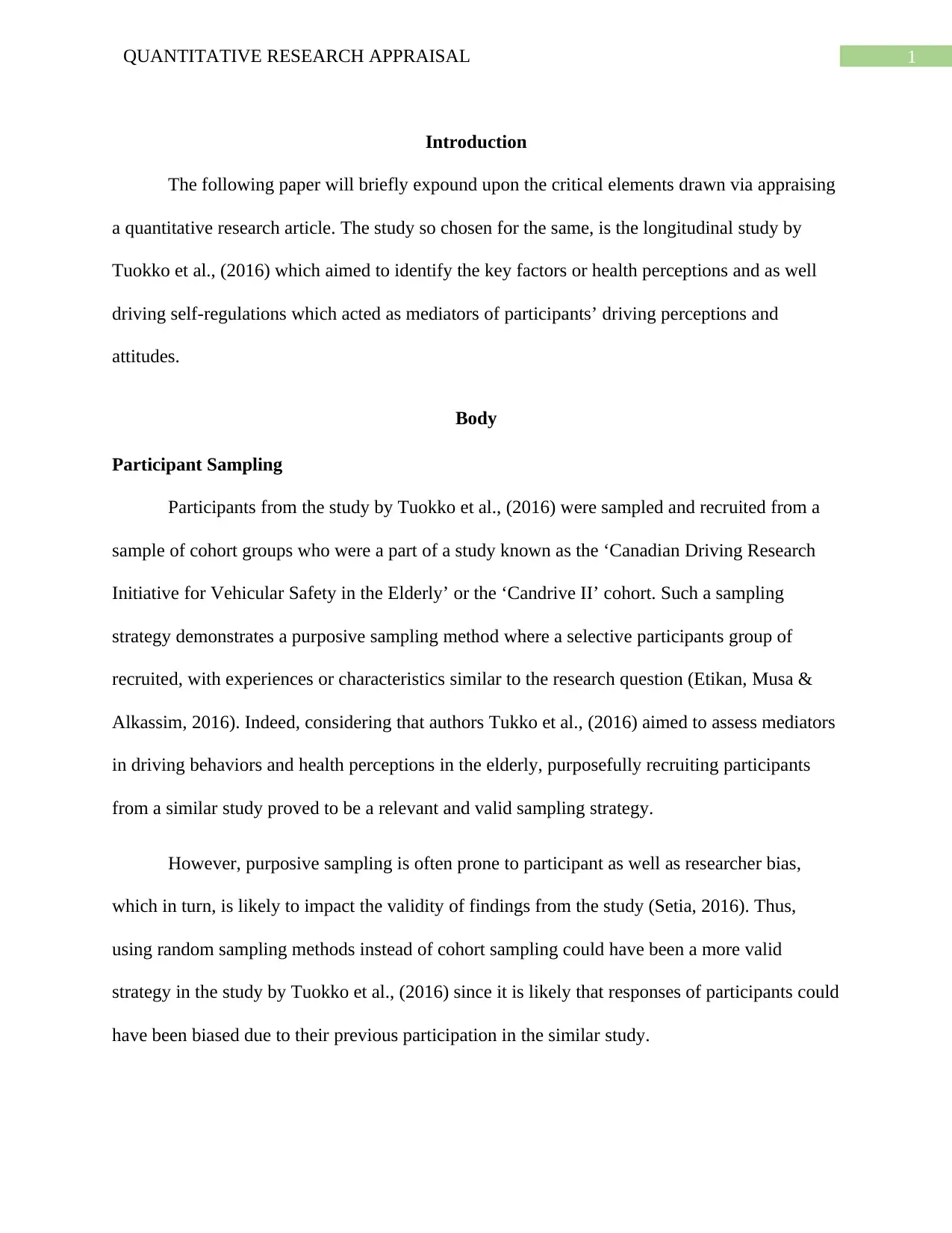
1QUANTITATIVE RESEARCH APPRAISAL
Introduction
The following paper will briefly expound upon the critical elements drawn via appraising
a quantitative research article. The study so chosen for the same, is the longitudinal study by
Tuokko et al., (2016) which aimed to identify the key factors or health perceptions and as well
driving self-regulations which acted as mediators of participants’ driving perceptions and
attitudes.
Body
Participant Sampling
Participants from the study by Tuokko et al., (2016) were sampled and recruited from a
sample of cohort groups who were a part of a study known as the ‘Canadian Driving Research
Initiative for Vehicular Safety in the Elderly’ or the ‘Candrive II’ cohort. Such a sampling
strategy demonstrates a purposive sampling method where a selective participants group of
recruited, with experiences or characteristics similar to the research question (Etikan, Musa &
Alkassim, 2016). Indeed, considering that authors Tukko et al., (2016) aimed to assess mediators
in driving behaviors and health perceptions in the elderly, purposefully recruiting participants
from a similar study proved to be a relevant and valid sampling strategy.
However, purposive sampling is often prone to participant as well as researcher bias,
which in turn, is likely to impact the validity of findings from the study (Setia, 2016). Thus,
using random sampling methods instead of cohort sampling could have been a more valid
strategy in the study by Tuokko et al., (2016) since it is likely that responses of participants could
have been biased due to their previous participation in the similar study.
Introduction
The following paper will briefly expound upon the critical elements drawn via appraising
a quantitative research article. The study so chosen for the same, is the longitudinal study by
Tuokko et al., (2016) which aimed to identify the key factors or health perceptions and as well
driving self-regulations which acted as mediators of participants’ driving perceptions and
attitudes.
Body
Participant Sampling
Participants from the study by Tuokko et al., (2016) were sampled and recruited from a
sample of cohort groups who were a part of a study known as the ‘Canadian Driving Research
Initiative for Vehicular Safety in the Elderly’ or the ‘Candrive II’ cohort. Such a sampling
strategy demonstrates a purposive sampling method where a selective participants group of
recruited, with experiences or characteristics similar to the research question (Etikan, Musa &
Alkassim, 2016). Indeed, considering that authors Tukko et al., (2016) aimed to assess mediators
in driving behaviors and health perceptions in the elderly, purposefully recruiting participants
from a similar study proved to be a relevant and valid sampling strategy.
However, purposive sampling is often prone to participant as well as researcher bias,
which in turn, is likely to impact the validity of findings from the study (Setia, 2016). Thus,
using random sampling methods instead of cohort sampling could have been a more valid
strategy in the study by Tuokko et al., (2016) since it is likely that responses of participants could
have been biased due to their previous participation in the similar study.
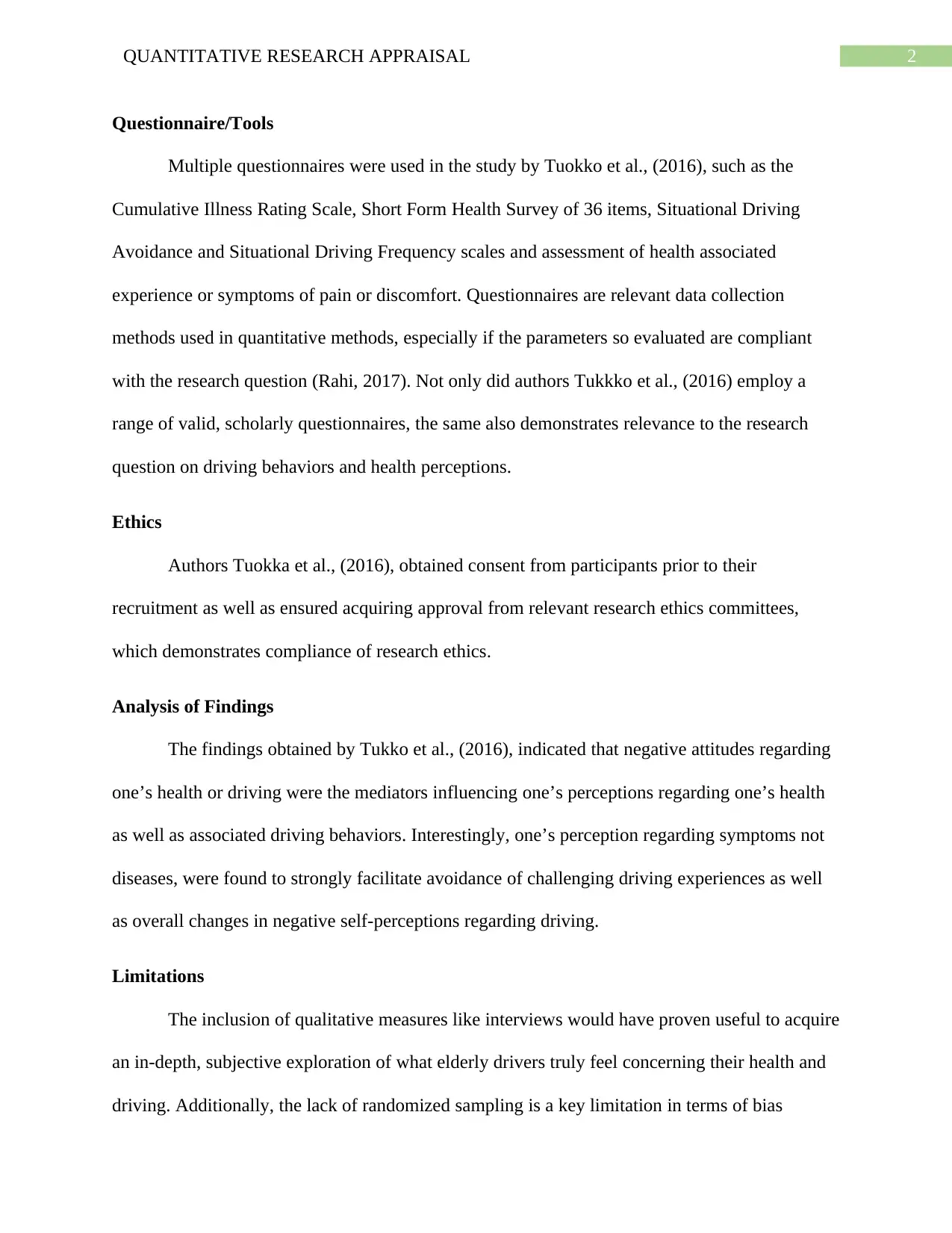
2QUANTITATIVE RESEARCH APPRAISAL
Questionnaire/Tools
Multiple questionnaires were used in the study by Tuokko et al., (2016), such as the
Cumulative Illness Rating Scale, Short Form Health Survey of 36 items, Situational Driving
Avoidance and Situational Driving Frequency scales and assessment of health associated
experience or symptoms of pain or discomfort. Questionnaires are relevant data collection
methods used in quantitative methods, especially if the parameters so evaluated are compliant
with the research question (Rahi, 2017). Not only did authors Tukkko et al., (2016) employ a
range of valid, scholarly questionnaires, the same also demonstrates relevance to the research
question on driving behaviors and health perceptions.
Ethics
Authors Tuokka et al., (2016), obtained consent from participants prior to their
recruitment as well as ensured acquiring approval from relevant research ethics committees,
which demonstrates compliance of research ethics.
Analysis of Findings
The findings obtained by Tukko et al., (2016), indicated that negative attitudes regarding
one’s health or driving were the mediators influencing one’s perceptions regarding one’s health
as well as associated driving behaviors. Interestingly, one’s perception regarding symptoms not
diseases, were found to strongly facilitate avoidance of challenging driving experiences as well
as overall changes in negative self-perceptions regarding driving.
Limitations
The inclusion of qualitative measures like interviews would have proven useful to acquire
an in-depth, subjective exploration of what elderly drivers truly feel concerning their health and
driving. Additionally, the lack of randomized sampling is a key limitation in terms of bias
Questionnaire/Tools
Multiple questionnaires were used in the study by Tuokko et al., (2016), such as the
Cumulative Illness Rating Scale, Short Form Health Survey of 36 items, Situational Driving
Avoidance and Situational Driving Frequency scales and assessment of health associated
experience or symptoms of pain or discomfort. Questionnaires are relevant data collection
methods used in quantitative methods, especially if the parameters so evaluated are compliant
with the research question (Rahi, 2017). Not only did authors Tukkko et al., (2016) employ a
range of valid, scholarly questionnaires, the same also demonstrates relevance to the research
question on driving behaviors and health perceptions.
Ethics
Authors Tuokka et al., (2016), obtained consent from participants prior to their
recruitment as well as ensured acquiring approval from relevant research ethics committees,
which demonstrates compliance of research ethics.
Analysis of Findings
The findings obtained by Tukko et al., (2016), indicated that negative attitudes regarding
one’s health or driving were the mediators influencing one’s perceptions regarding one’s health
as well as associated driving behaviors. Interestingly, one’s perception regarding symptoms not
diseases, were found to strongly facilitate avoidance of challenging driving experiences as well
as overall changes in negative self-perceptions regarding driving.
Limitations
The inclusion of qualitative measures like interviews would have proven useful to acquire
an in-depth, subjective exploration of what elderly drivers truly feel concerning their health and
driving. Additionally, the lack of randomized sampling is a key limitation in terms of bias
⊘ This is a preview!⊘
Do you want full access?
Subscribe today to unlock all pages.

Trusted by 1+ million students worldwide
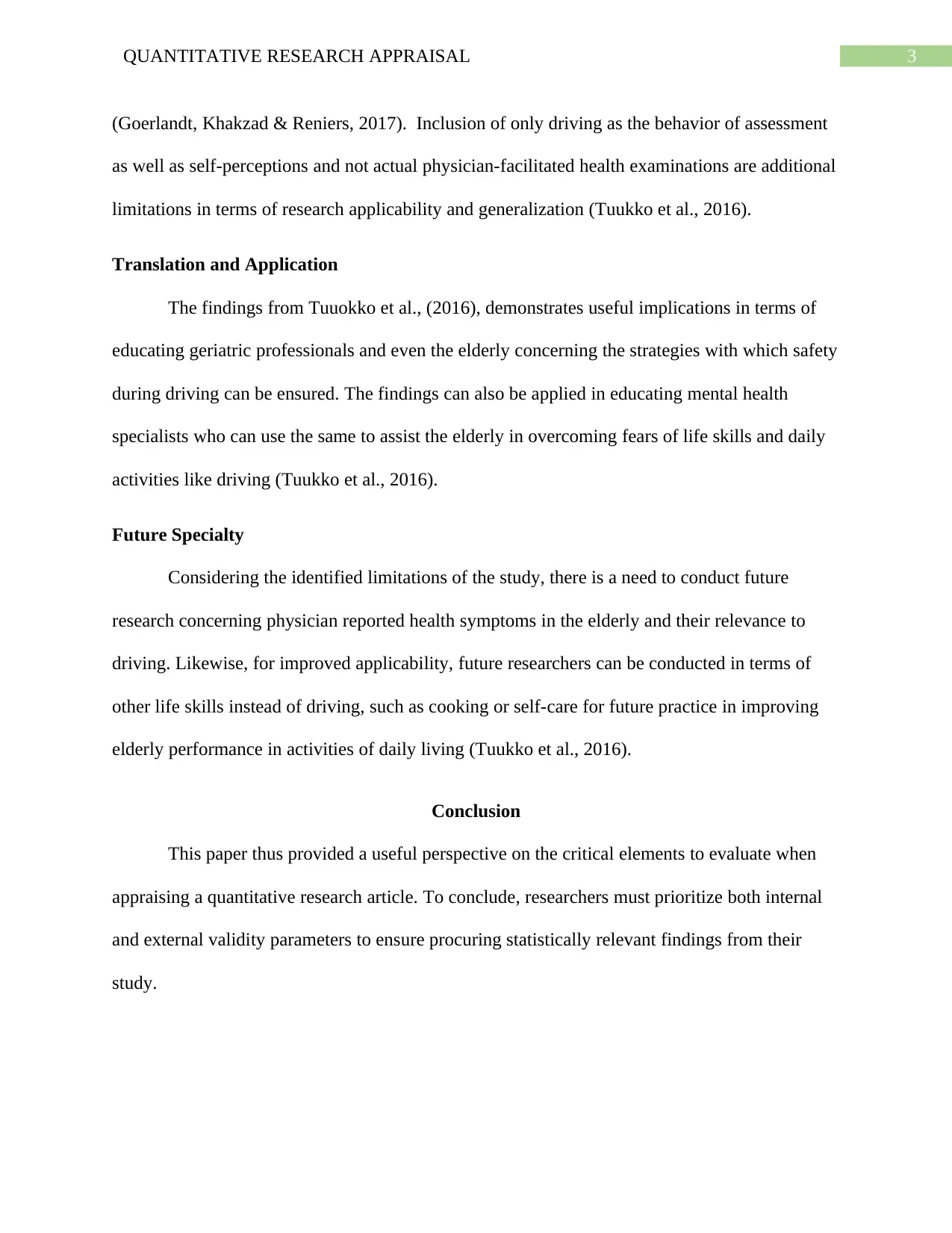
3QUANTITATIVE RESEARCH APPRAISAL
(Goerlandt, Khakzad & Reniers, 2017). Inclusion of only driving as the behavior of assessment
as well as self-perceptions and not actual physician-facilitated health examinations are additional
limitations in terms of research applicability and generalization (Tuukko et al., 2016).
Translation and Application
The findings from Tuuokko et al., (2016), demonstrates useful implications in terms of
educating geriatric professionals and even the elderly concerning the strategies with which safety
during driving can be ensured. The findings can also be applied in educating mental health
specialists who can use the same to assist the elderly in overcoming fears of life skills and daily
activities like driving (Tuukko et al., 2016).
Future Specialty
Considering the identified limitations of the study, there is a need to conduct future
research concerning physician reported health symptoms in the elderly and their relevance to
driving. Likewise, for improved applicability, future researchers can be conducted in terms of
other life skills instead of driving, such as cooking or self-care for future practice in improving
elderly performance in activities of daily living (Tuukko et al., 2016).
Conclusion
This paper thus provided a useful perspective on the critical elements to evaluate when
appraising a quantitative research article. To conclude, researchers must prioritize both internal
and external validity parameters to ensure procuring statistically relevant findings from their
study.
(Goerlandt, Khakzad & Reniers, 2017). Inclusion of only driving as the behavior of assessment
as well as self-perceptions and not actual physician-facilitated health examinations are additional
limitations in terms of research applicability and generalization (Tuukko et al., 2016).
Translation and Application
The findings from Tuuokko et al., (2016), demonstrates useful implications in terms of
educating geriatric professionals and even the elderly concerning the strategies with which safety
during driving can be ensured. The findings can also be applied in educating mental health
specialists who can use the same to assist the elderly in overcoming fears of life skills and daily
activities like driving (Tuukko et al., 2016).
Future Specialty
Considering the identified limitations of the study, there is a need to conduct future
research concerning physician reported health symptoms in the elderly and their relevance to
driving. Likewise, for improved applicability, future researchers can be conducted in terms of
other life skills instead of driving, such as cooking or self-care for future practice in improving
elderly performance in activities of daily living (Tuukko et al., 2016).
Conclusion
This paper thus provided a useful perspective on the critical elements to evaluate when
appraising a quantitative research article. To conclude, researchers must prioritize both internal
and external validity parameters to ensure procuring statistically relevant findings from their
study.
Paraphrase This Document
Need a fresh take? Get an instant paraphrase of this document with our AI Paraphraser
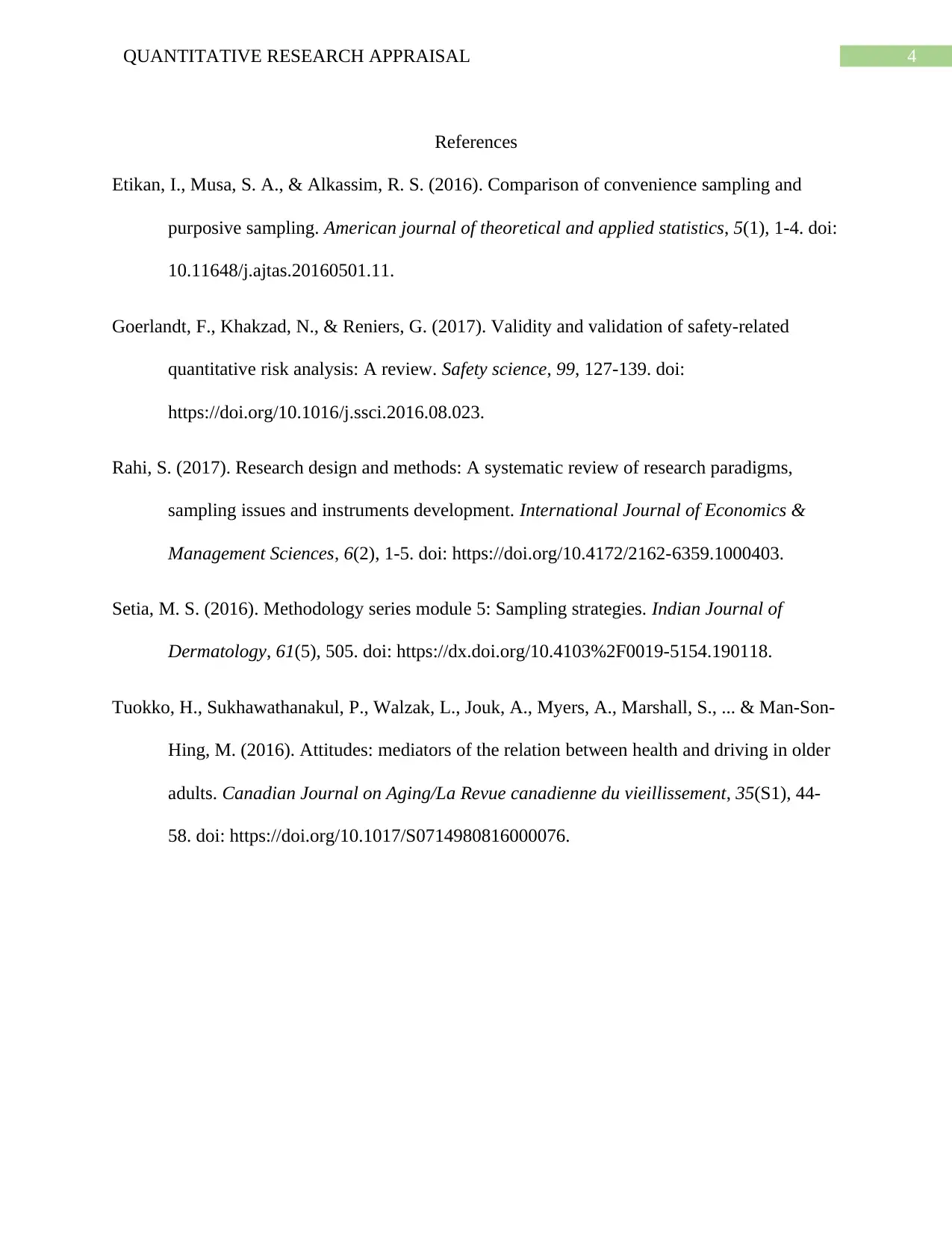
4QUANTITATIVE RESEARCH APPRAISAL
References
Etikan, I., Musa, S. A., & Alkassim, R. S. (2016). Comparison of convenience sampling and
purposive sampling. American journal of theoretical and applied statistics, 5(1), 1-4. doi:
10.11648/j.ajtas.20160501.11.
Goerlandt, F., Khakzad, N., & Reniers, G. (2017). Validity and validation of safety-related
quantitative risk analysis: A review. Safety science, 99, 127-139. doi:
https://doi.org/10.1016/j.ssci.2016.08.023.
Rahi, S. (2017). Research design and methods: A systematic review of research paradigms,
sampling issues and instruments development. International Journal of Economics &
Management Sciences, 6(2), 1-5. doi: https://doi.org/10.4172/2162-6359.1000403.
Setia, M. S. (2016). Methodology series module 5: Sampling strategies. Indian Journal of
Dermatology, 61(5), 505. doi: https://dx.doi.org/10.4103%2F0019-5154.190118.
Tuokko, H., Sukhawathanakul, P., Walzak, L., Jouk, A., Myers, A., Marshall, S., ... & Man-Son-
Hing, M. (2016). Attitudes: mediators of the relation between health and driving in older
adults. Canadian Journal on Aging/La Revue canadienne du vieillissement, 35(S1), 44-
58. doi: https://doi.org/10.1017/S0714980816000076.
References
Etikan, I., Musa, S. A., & Alkassim, R. S. (2016). Comparison of convenience sampling and
purposive sampling. American journal of theoretical and applied statistics, 5(1), 1-4. doi:
10.11648/j.ajtas.20160501.11.
Goerlandt, F., Khakzad, N., & Reniers, G. (2017). Validity and validation of safety-related
quantitative risk analysis: A review. Safety science, 99, 127-139. doi:
https://doi.org/10.1016/j.ssci.2016.08.023.
Rahi, S. (2017). Research design and methods: A systematic review of research paradigms,
sampling issues and instruments development. International Journal of Economics &
Management Sciences, 6(2), 1-5. doi: https://doi.org/10.4172/2162-6359.1000403.
Setia, M. S. (2016). Methodology series module 5: Sampling strategies. Indian Journal of
Dermatology, 61(5), 505. doi: https://dx.doi.org/10.4103%2F0019-5154.190118.
Tuokko, H., Sukhawathanakul, P., Walzak, L., Jouk, A., Myers, A., Marshall, S., ... & Man-Son-
Hing, M. (2016). Attitudes: mediators of the relation between health and driving in older
adults. Canadian Journal on Aging/La Revue canadienne du vieillissement, 35(S1), 44-
58. doi: https://doi.org/10.1017/S0714980816000076.
1 out of 5
Related Documents
Your All-in-One AI-Powered Toolkit for Academic Success.
+13062052269
info@desklib.com
Available 24*7 on WhatsApp / Email
![[object Object]](/_next/static/media/star-bottom.7253800d.svg)
Unlock your academic potential
Copyright © 2020–2025 A2Z Services. All Rights Reserved. Developed and managed by ZUCOL.





